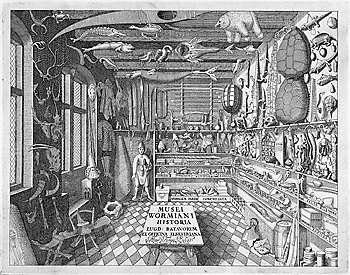The Danish collection of Ole Worm is indicative of the growing interest in cabinets of natural history in the seventeenth century and the diffusion of an enthusiasm for collecting from Italy to northern Europe. Like Aldrovandi, whose work had a profound influence on Worm, the Museum Wormianum was formed with a significant professional purpose in mind, namely medical education.
Worm was Professor of Medicine at the University of Copenhagen for most of the period in which he was amassing the collection of his museum. But his background had given him the extensive skills required of an ambitious collector: he had travelled widely and had previously held the University chairs of Latin, Greek and natural philosophy.
The museum was arranged according to a hierarchical taxonomy, rising from stones and minerals, through plants and animals to human anatomy and artificial products. This is reflected in the catalogue published in 1655, the year after Worm’s death. The collection itself was absorbed into the royal Kunstkammer, founded in 1650, but it was Worm’s catalogue – particularly its splendid plate of the interior of his museum – that secured his position in the history of the discipline. |




